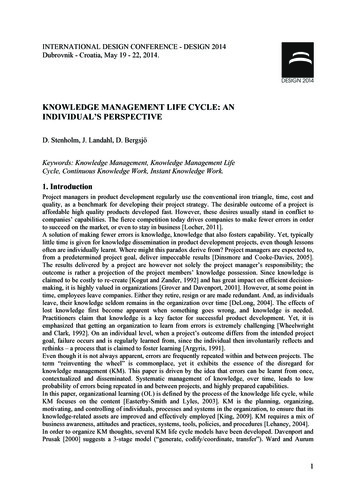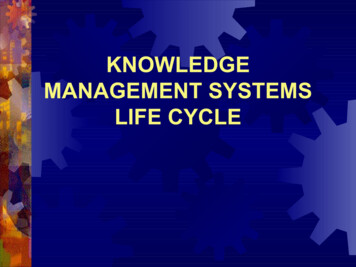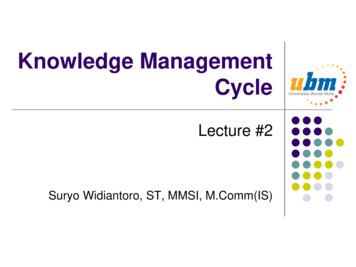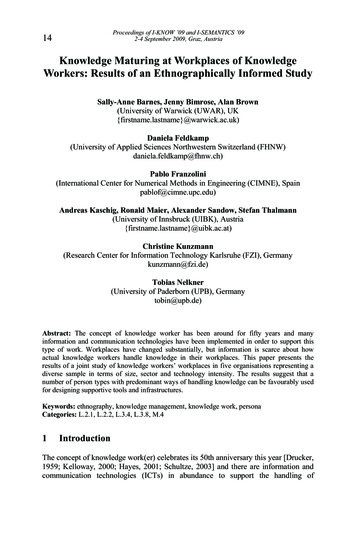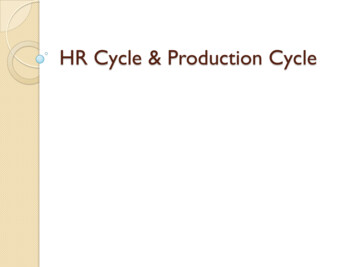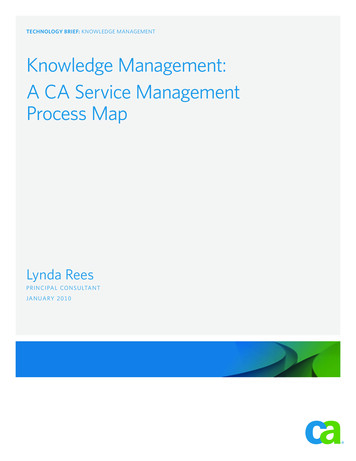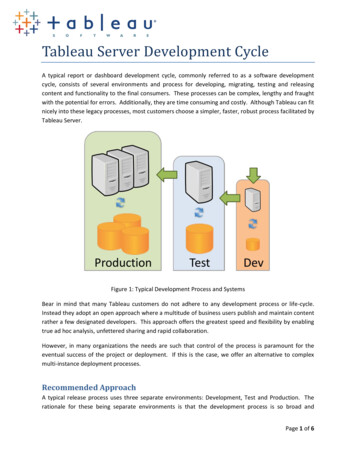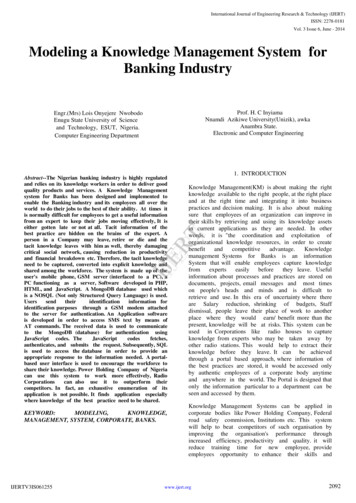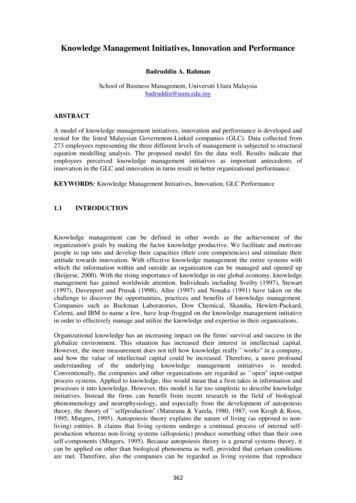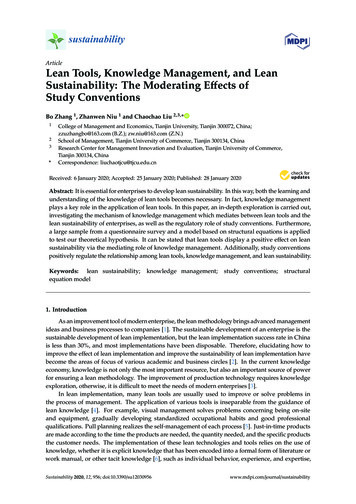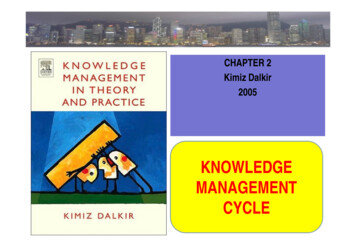
Transcription
CHAPTER 2Kimiz Dalkir2005KNOWLEDGEMANAGEMENTCYCLE
A little knowledge that act is worthinfinitely more than much knowledgethat is idle- Khalil gibran -KNOWLEDGEMANAGEMENTCYCLE
OBJECTIVES1. Describe the impotance of individual, group, & organizationknowledge management (create, capture, share, codify,access, applied, reuse)2. Compare the major KM cycle (Zack, McElroy, Wiig, &Bukowits and Williams)3. Define the key step in each process of KM cycle4. Identify the challenge & benefit of each KM cycle phase5. Describe the way integrated KM cycle combine theadvantages of other KM model14 September 2012KM Teaching Group - MBTI 2012
WHAT KM PROCESS DOES Identify knowledge and knowledge resources inorganization Transform valuable knowledge into explicit form codification Disseminate thru practices, sharing, networks Use for decision making, problem solving, choosing thebest practices for every situation Store the knowledge in organization memory14 September 2012KM Teaching Group - MBTI 2012
A COMPARISON14 September 2012KM Teaching Group - MBTI 2012
MAJOR APPROACHES Zack KM cycle - 1996Bukowits and Williams KM cycle - 2000McElroy KM cycle - 2003Wiig KM cycle – 1993Integrated cycle14 September 2012KM Teaching Group - MBTI 2012
SIKLUS KM ZACK Basic concept Research and knowledge about the design of physical productcan be extended into the intellectual realms to serve as the basisof the KM cycle14 September 2012KM Teaching Group - MBTI 2012
SIKLUS KM ZACK Analogies : Product Platform (repository) Information Process Platform (refinery) Higher value-added to leverage knowledge Ex : basic data trend (repackaged) dec. Making Please find real life example Emphasize on evolution & renewal of ‘product architecture’to sustain competitiveness Different architecture, different product function, cost, quality,performance14 September 2012KM Teaching Group - MBTI 2012
SIKLUS KM ZACK Compose of technolgy, facilities, & process formanufacturing product/service Viewed as repository comprise of information content &structure Content is unique Structure that can easily identify, extract, & manage differentknowledge (sifting & modification) Labelling, indexing, linking, cross-referencing Repository become foundation for the firm to create thefamily of information & knowledge14 September 2012KM Teaching Group - MBTI 2012
SIKLUS KM ZACK Aquisition Breadth, depth, scope, credibility, accuracy, timelines, relevance,cost, exclusivity, quality Refinement Migrating, restructuring, relabelling, integrating, cleaning up,sifting, interpret, standarizing, Creating readily useable knowledge Store/retrieve A bridge between upstream aquisition, refinement, &downstream stages14 September 2012KM Teaching Group - MBTI 2012
SIKLUS KM ZACK Distribution How to deliver product to end user, Medium of delivery, timing, frequency, form Use How the product support the work of the end user The strength of the cycle comprehensive informationprocessing paradigm14 September 2012KM Teaching Group - MBTI 2012
SIKLUS KM BUKOWITS The way the organization create, generate, maintain, anddeploye a strategically correct stock of knowledge to createvalue14 September 2012KM Teaching Group - MBTI 2012
SIKLUS KM BUKOWITZ Get – Learn – Distribute : tactical (drive by demand) Assess – Build – Divest : strategic (triger by macroenvironment)14 September 2012KM Teaching Group - MBTI 2012
SIKLUS KM BUKOWITZ GET : seek information, deal with enormous info, match infoneed, know the resources, cybraryan. USE : combine information to innovate, decision making &problem solving LEARN : experiences to create competitive advantage, usingorganizational memory (lesson learned – best practise) CONTRIBUTE : post what is learned to the public knowledge14 September 2012KM Teaching Group - MBTI 2012
SIKLUS KM BUKOWITZ ASSESS : evaluate & map intellectual capital, define missioncritical knowledge, compare with the future need Measure the knowledge investment onto performance Identify new form of capital BUILD / SUSTAIN : develop intellectual capital to keeporganization viable & competitive DIVEST : is the knowledge still worth to keep or better oftransfer to outside (see p. 35)14 September 2012KM Teaching Group - MBTI 2012
SIKLUS Mc ELROY Knowledge life cycle consists of the processes of knowledgeproduction and knowledge integration, with a series offeedback loops to organizational memory, beliefs, andclaims and the business-processing environment Knowledge held in the mind of individual & group Knowledge use in the business process : Match expectation store & reuse Fail adjust Successive failure reject & create new knowledge14 September 2012KM Teaching Group - MBTI 2012
SIKLUS Mc ELROY14 September 2012KM Teaching Group - MBTI 2012
SIKLUS Mc ELROY hh14 September 2012KM Teaching Group - MBTI 2012
SIKLUS Mc ELROY14 September 2012KM Teaching Group - MBTI 2012
SIKLUS Mc ELROY hh14 September 2012KM Teaching Group - MBTI 2012
SIKLUS Mc ELROY Knowledge Integration Process by which organization introduce new knowledge claim toits operating environment and retire the old one (or ?) Conducted thru teaching, training, sharing, & others activitieswhich communicate the understanding of new knowledge to theworker (replace or integrate with the old knowledge)14 September 2012KM Teaching Group - MBTI 2012
SIKLUS Mc ELROY Positive side Clear description of how to evaluate knowledge Concious decision to integrate knowledge into org. memory or not This validation separate KM from document management KM focus on process to identify the knowledge content thatis of value to organization and employee14 September 2012KM Teaching Group - MBTI 2012
SIKLUS KM WIIG Three conditions that need to be present for an organizationto conduct its business successfully: Business (products/services) and customers Resources (people, capital, facilities) Ability to act Ability to act intelligently determined and drived by theknowledge Improved knowledge mean we know better about what &how to do14 September 2012KM Teaching Group - MBTI 2012
SIKLUS KM WIIG14 September 2012KM Teaching Group - MBTI 2012
SIKLUS KM WIIG BUILDING KNOWLEDGE Obtain knowledge. Analyze knowledge. Reconstruct/synthesize knowledge. Codify and model knowledge. Organize knowledge.14 September 2012KM Teaching Group - MBTI 2012
SIKLUS KM WIIG HOLDING KNOWLEDGE remembering, accumulating knowledge in repositories, embedding knowledge in repositories, archiving knowledge14 September 2012KM Teaching Group - MBTI 2012
SIKLUS KM WIIG POOLING KNOWLEDGE coordinating, assembling, accessing and retrieving knowledge.14 September 2012KM Teaching Group - MBTI 2012
SIKLUS KM WIIG USE KNOWLEDGE perform a routine task (make standard products, provide astandard service, or use the expert network to find out who isknowledgeable about a particular area). survey exceptional situations at hand (determine what the problemis and estimate potential consequences) describe the situation and scope of the problem (identify problemand show generally how to handle it) Select relevant special knowledge to handle the situation (identifywho you need to consult with or want to address the problem).14 September 2012KM Teaching Group - MBTI 2012
SIKLUS KM WIIG USE KNOWLEDGE Observe and characterize the situation with special knowledge(make a comparison with known patterns, take a history, & collectand organize required information to act. Analyze the situation with knowledge (judge whether it can behandled internally or whether outside help will be required) Synthesize alternative solutions with knowledge (identify optionsand outline possible approaches). Evaluate potential alternatives using special knowledge(determine the risks and benefits of each possible approach.14 September 2012KM Teaching Group - MBTI 2012
SIKLUS KM WIIG USE KNOWLEDGE Use knowledge to decide what to do (rank alternatives, select one,and do a reality check). mplement the selected alternative—for example, execute the taskand authorize the team to proceed14 September 2012KM Teaching Group - MBTI 2012
SIKLUS KM WIIG14 September 2012KM Teaching Group - MBTI 2012
CYCLE CRITERIA’s SELECTION Implemented and validated in real world Comprehensive to different types of steps in KM literature Detail description of KM cycle14 September 2012KM Teaching Group - MBTI 2012
INTEGRATED CYCLE Three major stage in KM cycle Knowledge capture / creation Knowledge sharing / dissemination Knowledge acquisition / application14 September 2012KM Teaching Group - MBTI 2012
INTEGRATED CYCLE14 September 2012KM Teaching Group - MBTI 2012
SUMBER INFORMASI .htm ment%20system.htm ent-context/ http://www.lc-stars.com/knowledge.html wledgemanagement-in-the-call-center-industry/ http://www.ugc.edu.hk/tlqpr01/site/abstracts/098 hui.htm ility/activities/knowledge.htm14 September 2012KM Teaching Group - MBTI 2012
/tacit-explicitknowledge.htm tTacit.htm ipe-knowledgeyaitu.html http://www.systems-thinking.org/kmbh/kmbh.htm http://www.kmnetwork.com/WhatIsKM.html14 September 2012KM Teaching Group - MBTI 2012
DRESSED 4 SUCCESS Review singkat materi perkuliahan ini minimal 1 kali setiapminggu. Selesaikan penugasan2, baik yang dikumpulkan atau yang tidak. Membuat catatan kecil (rangkuman) yang mudah dipelajari saatmenghadapi UTS/UAS (bukan untuk ‘contekan’). Setidaknya baca & pahami materi secara lengkap pada bukupanduan utama. Perhatikan pokok bahasan yang diberikan penegasan olehdosen beserta contoh2-nya. Cari materi dari dosen lain dengan pokok bahasan yang sama.14 September 2012KM Teaching Group - MBTI 2012
knowledge management (create, capture, share, codify, access, applied, reuse) 2. Compare the major KM cycle (Zack, McElroy, Wiig, & Bukowits and Williams) 3. Define the key step in each process of KM cycle 4. Identify the challenge & benefit of each KM cycle phase 5. Describe the way integrated KM cycle combine the advantages of other KM modelFile Size: 1MB
